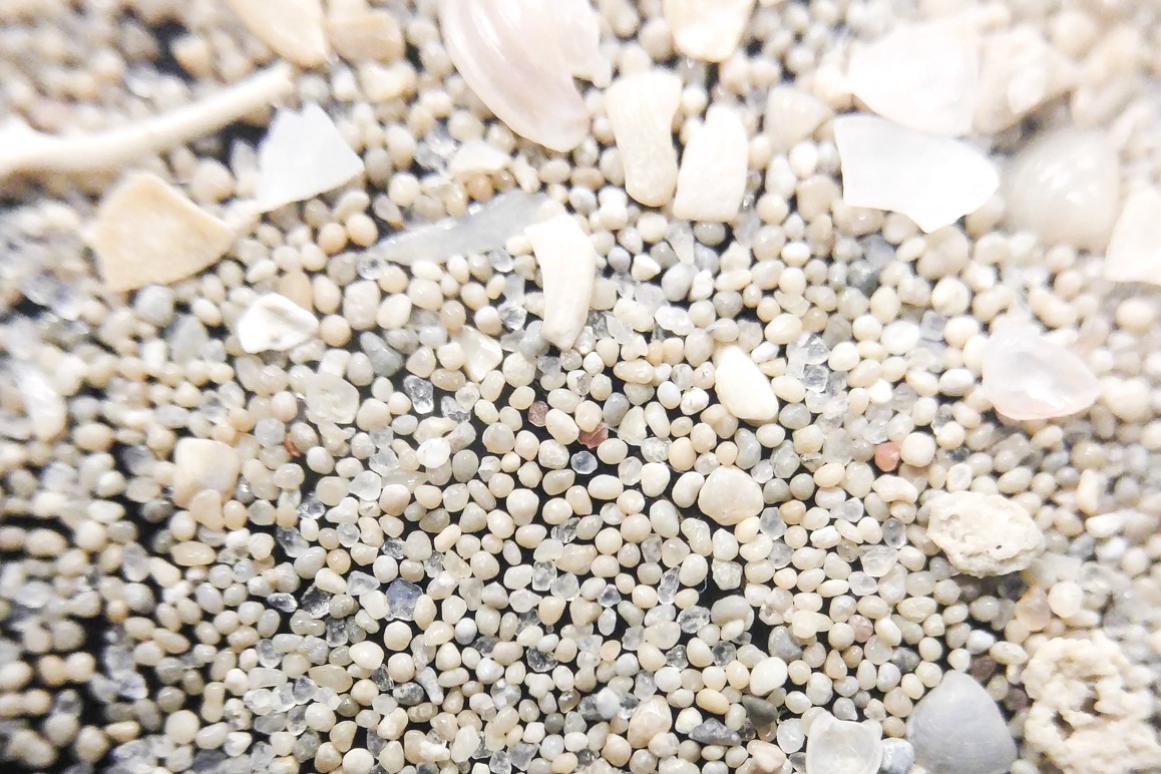“Jewels" of Baffin Bay shared with UK science center

HRI Associate Research Scientist Dr. Mark Besonen shares an interesting tidbit with us from both our Coastal and Marine Geospatial Sciences (CMGL) and Coastal Conservation and Restoration (CCR) labs highlighting HRI's international reach:
"Baffin Bay is frequently referred to as a 'jewel' of the South Texas coast for its renowned saltwater fishery, which has produced many state records for huge redfish, black drum, and spotted seatrout. But it is also surprisingly well-known in geological circles because it produces a rather uncommon type of sediment that is more often associated with hypersaline environments like the Persian Gulf, or carbonate banks like the Bahamas. The sediment, known as ooid sand (pronounced “oh-id”), consists of sand-sized grains that form by the gradual accumulation of concentric layers of the mineral calcite, usually around a smaller nucleus grain like a speck of silt or very small shell fragment. This means that ooid sand is different from almost all other types of sand out there because most sand normally forms from the progressive breakdown of larger grains like rocks or pebbles whereas ooids grains actually grow to sand size. In this sense, ooids form very much like how a pearl grows inside of an oyster’s gut —i.e. layer by layer — but directly in shallow, warm waters without the need for an oyster. The similarity does not end there —pearls are primarily composed of the mineral calcite just like the ooids of Baffin Bay. This gives a whole new depth to the idea of Baffin Bay being a 'jewel' of the South Texas coast, indeed, it is the birthplace and home of billions and billions of tiny little pearl-like ooid jewels!
In fall 2019, by a winding chain of contacts, the CMGL received a request for an ooid sand sample from We The Curious, a science center and educational charity in Bristol, UK. The center has received support from the Wellcome Trust Inspiring Science Fund to reimagine their whole ground floor experience by developing a new exhibition called “Project What If” based entirely on questions gathered from people across the whole of Bristol. This new exhibition will include over 70 new individual exhibits, and is due to launch in Autumn 2020. One of the questions the group received was 'Who was the first person to see sand?' To address the question, the group is developing an exhibit called 'Sand Around the World,' which, as the title suggests, will show the beauty of different sand types from around the world, linking them geographically to fossil and archaeological finds that evidence the migration of early humans. Visitors will be able to discover the unexpected beauty and variation of different sand grains under a video microscope, with a digital screen that presents information on the sand type and related fossil find. The ooid sand from Baffin Bay will be linked to the Clovis spearheads found in New Mexico, which evidence a prehistoric Paleoamerican culture of approximately 14,000 years ago.
To help provide an ooid sand sample for this effort, CMGL staff worked with the CCR lab here at HRI, who are actively working in Baffin Bay to study the serpulid reef systems there, to coordinate a few grab samples of sediment in the system. Ooids are not found everywhere in the system, and instead are found mostly around the northern central part of the bay around Kleberg Point. With this guidance, Terry Palmer, a Ph.D. candidate and technician in the CCR group, was able to retrieve three sediment samples from the shallow waters off of Kleberg Point during field work in early December 2019. CMGL staff processed the samples during spring 2020 by first confirming that they contained ooids, and then cleaning, sieving, and drying them before sending them off to Bristol for inclusion in the exhibit.
If you are in the area, we encourage you to visit We The Curious to see some of the many thousands of tiny Baffin Bay jewels that are now part of their 'Sand Around the World' exhibit!"
(image description: The smooth, round to ovular grains are ooids that grew in Baffin Bay. They are generally cream-colored, but white, gray, and brown ooids are also visible. Many, but not all, have a beautiful, pearlescent sheen. The glassy, transparent grains are common quartz.)
